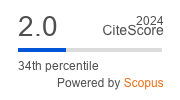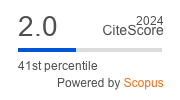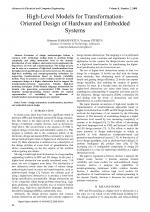| 2/2008 - 16 | View TOC | « Previous Article | Next Article » |
High-Level Models for Transformation-Oriented Design of Hardware and Embedded SystemsDAMASEVICIUS, R. |
| Extra paper information in |
| Click to see author's profile in |
| Download PDF |
Author keywords
design automation, transformation, hardware and embedded system design
References keywords
design(37), model(29), software(22), systems(17), embedded(13), system(12), driven(12), damasevieius(11), stuikys(10), development(9)
Blue keywords are present in both the references section and the paper title.
About this article
Date of Publication: 2008-06-02
Volume 8, Issue 2, Year 2008, On page(s): 86 - 94
ISSN: 1582-7445, e-ISSN: 1844-7600
Digital Object Identifier: 10.4316/AECE.2008.02016
Web of Science Accession Number: 000264815000016
SCOPUS ID: 77954751851
Abstract
Evolution of design methodologies follows a common trail: technology scaling leads to growing design complexity and rising abstraction level in the domain. Introduction of new (higher) abstraction levels emphasizes the importance of reuse and transformations. The design process can be seen as a sequence of high-level transformations from the higher-level specification to the lower-level one. We analyze high-level modeling and metaprogramming techniques for supporting transformations based on domain variability models. Next, we present a reuse evolution model for domain component design at a higher abstraction level to support the transformation-oriented approaches. Finally, high-level modeling techniques (UML-domain language metamodels for domain code generation, parameterized UML classes for template metaprogramming, feature models for explicit representation of variability) for specification of transformations and metaprograms are analyzed. |
| References | | | Cited By |
Web of Science® Times Cited: 2 [View]
View record in Web of Science® [View]
View Related Records® [View]
Updated 3 weeks, 5 days ago
SCOPUS® Times Cited: 2
View record in SCOPUS® [Free preview]
View citations in SCOPUS® [Free preview]
[1] Simulations and Analysis and Operating Regime as Rectifier with Power Factor Correction of Two - Quadrant Converter with RNSIC, PLETEA, I.V., PLETEA, M., ALEXA, D., LUCANU, N., Advances in Electrical and Computer Engineering, ISSN 1582-7445, Issue 3, Volume 9, 2009.
Digital Object Identifier: 10.4316/aece.2009.03004 [CrossRef] [Full text]
Disclaimer: All information displayed above was retrieved by using remote connections to respective databases. For the best user experience, we update all data by using background processes, and use caches in order to reduce the load on the servers we retrieve the information from. As we have no control on the availability of the database servers and sometimes the Internet connectivity may be affected, we do not guarantee the information is correct or complete. For the most accurate data, please always consult the database sites directly. Some external links require authentication or an institutional subscription.
Web of Science® is a registered trademark of Clarivate Analytics, Scopus® is a registered trademark of Elsevier B.V., other product names, company names, brand names, trademarks and logos are the property of their respective owners.
Faculty of Electrical Engineering and Computer Science
Stefan cel Mare University of Suceava, Romania
All rights reserved: Advances in Electrical and Computer Engineering is a registered trademark of the Stefan cel Mare University of Suceava. No part of this publication may be reproduced, stored in a retrieval system, photocopied, recorded or archived, without the written permission from the Editor. When authors submit their papers for publication, they agree that the copyright for their article be transferred to the Faculty of Electrical Engineering and Computer Science, Stefan cel Mare University of Suceava, Romania, if and only if the articles are accepted for publication. The copyright covers the exclusive rights to reproduce and distribute the article, including reprints and translations.
Permission for other use: The copyright owner's consent does not extend to copying for general distribution, for promotion, for creating new works, or for resale. Specific written permission must be obtained from the Editor for such copying. Direct linking to files hosted on this website is strictly prohibited.
Disclaimer: Whilst every effort is made by the publishers and editorial board to see that no inaccurate or misleading data, opinions or statements appear in this journal, they wish to make it clear that all information and opinions formulated in the articles, as well as linguistic accuracy, are the sole responsibility of the author.



